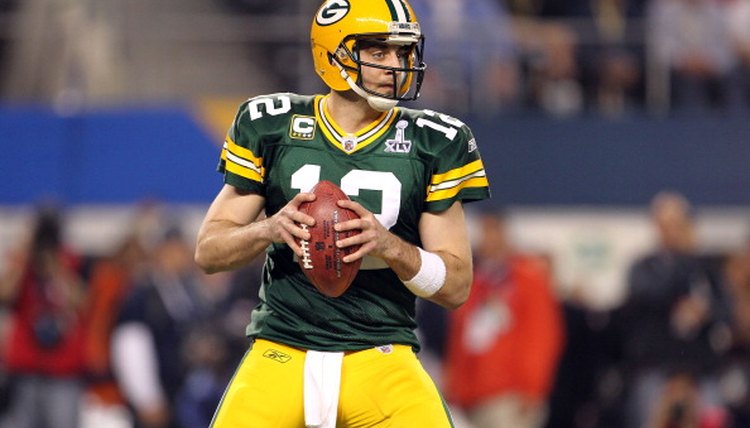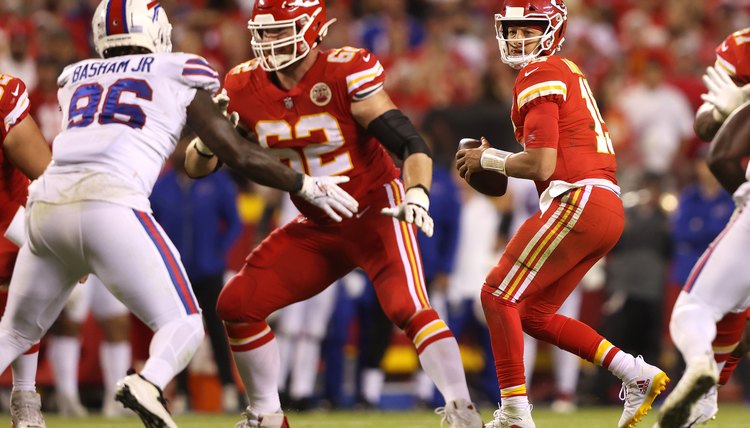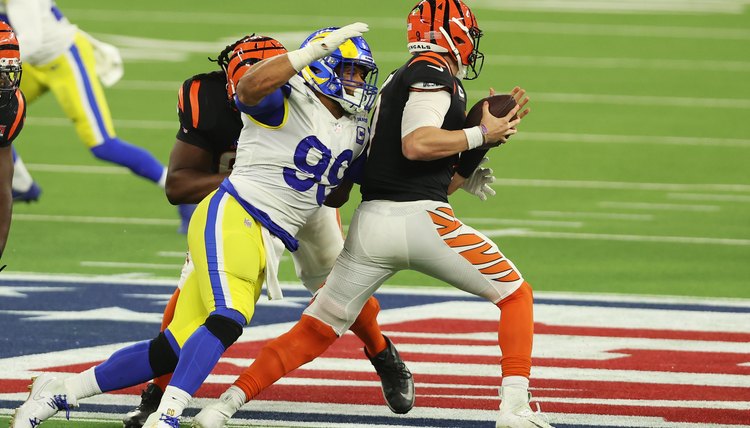Football Rules for the Tackle Box Dimensions (includes Video)

The tackle box in American Football is an area that is commonly known as the pocket. When a quarterback sets up to pass, particularly at the professional level, he generally does that in the pocket. He will drop back five to seven steps, survey the field and then deliver the ball to a receiver. The tackle box exists in all levels of football including high school. The quarterback, his blockers and the defensive players must follow several football rules when they are in this area.
What is the Tackle Box?
The tackle box extends two yards outside the two offensive tackles stationed on the line of scrimmage and goes backfield all the way -- in theory -- to the offensive team's goal line or end zone. On the standard offensive line, players will line up at left tackle, left guard, center, right guard and right tackle. The starting points of the tackle box are 2 yards to the left of the left tackle's shoulder and 2 yards to the right of the right tackle's shoulder.
What is Intentional Grounding?
When inside the tackle box, the quarterback must attempt to throw the ball directly to a receiver. A quarterback cannot survey the field, determine that none of his eligible receivers are open and then throw the ball away towards the sideline to avoid a sack or fumble. A quarterback who does that while in the tackle box is guilty of intentionally grounding the football. The penalty for an intentional grounding infraction is loss of yardage to the spot where the quarterback threw the dead ball and loss of down. This means if a quarterback does that on fourth down it is a change of possession and first down for the opposing offense. If the quarterback moves to his right or left, and gets outside of the tackle box, he can throw the ball away by throwing it off the turf or out of bounds, as long as the ball crosses the line of scrimmage.
Offensive Linemen Rules

Jamie Squire/Getty Images Sport/Getty Images
Offensive linemen and tight ends, who are blocking for the quarterback, must be careful not to grab any part of the defensive player they are blocking outside the shoulder pads when they are in the tackle box. Offensive linemen may extend their hands and arms when they block, but they may not grab a handful of uniforms while doing so or block below the waist. This is easily noticeable when the offensive lineman is inside the tackle box as the line judge -- one of the football game officials -- is charged with watching blocking technique and must make sure it is legal. If not, a holding call is made. A holding call on the offense results in a 10-yard penalty and a replay of the down. This can be back breaking on a play where a touchdown is scored.
Defensive Linemen Rules

Jamie Squire/Getty Images Sport/Getty Images
If defensive linemen get through an offensive player's block and have a chance to get to the quarterback and sack him, they have to be quite precise in their tackling technique. For example, the defensive lineman cannot grab a ball carrier and slam him to the turf or lead with his helmet after a successful blitz. When tackling the quarterback in the tackle box, you must grab the quarterback somewhere above the knees and shoulders and wrap him up while tackling. Leading with the helmet is illegal and so is tackling below the knees and will result in a 15-yard penalty. These limitations only apply when hitting the quarterback within the tackle box. If the quarterback has run outside the box or run downfield, the defensive player is allowed to hit or tackle the quarterback as if he were a running back and none of the protective rules apply. The same rules apply on kicks and punts. Running into the kicker on an extra point or field goal also carries a penalty.
References
Writer Bio
Blaise is a Freshman at the University of Missouri, studying Journalism at the world-renowned J school. He is the host of the Fast Five Podcast with his Childhood friend Sam Sinclair and interns with the Sports AI platform Pine Sports. He is a huge fan of the Kansas City Chiefs and the St Louis. Cardinals and hopes to cover them professionally in his near future.
